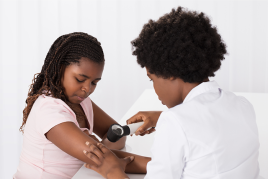Can you get eczema as an adult?
Adults can get any type of eczema, including atopic dermatitis (AD), which many people consider a childhood disease.
When AD begins after your 18th birthday, dermatologists call it adult-onset atopic dermatitis. You’d receive this diagnosis if you never had AD before. A peak time for developing adult-onset AD is in your 50s.
AD and the eyes
In adults, atopic dermatitis (AD) often develops on skin around the eyes.

Some adults who have AD had it as a child. It’s possible for AD to go away in childhood and return years later. When the AD returns, it’s often much milder.
For some children, the AD never goes away, so it’s a lifelong disease. This happened to Peter Moffat, the award-winning writer of the British TV series Criminal Justice. You can read about how AD affects his life by going to: Adults with eczema too often suffer in silence
Differences between AD in adults and children
Even if you had AD as a child, your skin can look and feel differently when you have AD as an adult. That’s actually one of the most striking differences between AD in adults and AD in children.
In adults, the skin tends to be extremely dry and scaly where the AD appears.
If you’ve had AD for years, patches of your skin may be thick, leathery, and darker (or lighter) than the surrounding skin. Years of scratching causes this. The thickened skin can itch all the time.
Adults also tend to get AD on different parts of their bodies than do children. When an adult has AD, it’s most likely to form in one or more of these areas:
Backs of the knees
Crooks of the elbows
Back of the neck
Face
Adults, unlike children, often have AD around their eyes. You’ll often see thickened, darker skin circling the eyes, as shown in the picture on this page. The skin around the eyes also tends to be very itchy.
Similarities between AD in adults and children
While AD tends to change how it looks and where it appears as we age, there are still many similarities between having AD as an adult and as a child.
The list of similarities often includes that AD can:
Appear anywhere on the skin
Be intensely itchy
Cause sleep loss due to the itch
Make you feel depressed, anxious, or both
Lead to skin infections
Increase your risk of developing asthma, hay fever, and other allergies
Decrease your quality of life if left untreated
More adults and children developing AD
The numbers show that more children and adults are developing AD than ever before.
Dermatologists aren’t sure why this is happening. What they have discovered is that AD can worsen without treatment.
An accurate diagnosis is essential
While AD causes some obvious signs and symptoms, other types of eczema can cause intensely itchy patches of skin. These include:
Each of these skin conditions requires different treatment, so it’s important to know which one you have.
Treatment can bring relief
By seeing a board-certified dermatologist, you’ll get the expertise you need for an accurate diagnosis. A dermatologist can also create a treatment plan tailored to your individual needs. And that can bring welcomed relief.
Related AAD resources
Image
Used with permission of the Journal of the American Academy of Dermatology. J Am Acad Dermatol 2001;44:89-93.
References
Eichenfield LF, Tom WL, et al. “Guidelines of care for the management of atopic dermatitis. Section 1. Diagnosis and assessment of atopic dermatitis.” J Am Acad Dermatol. 2014; 70:338-51.
Ellis CN, Mancini AJ, et al. “Understanding and managing atopic dermatitis in adult patients.” Semin Cutan Med Surg. 2012; 31(3 Suppl):S18-22
Kanwar AJ. “Adult-onset atopic dermatitis.” Indian J Dermatol. 2016 Nov-Dec; 61(6): 662–3.
Kim JP, Chao LX, et al. “Persistence of atopic dermatitis (AD): A systematic review and meta-analysis.” J Am Acad Dermatol. 2016; 75:681-7.
Silverberg JI, Vakharia PP, et al. “Phenotypical differences of childhood- and adult-onset atopic dermatitis.” J Allergy Clin Immunol Pract. 2017 Nov 10. pii: S2213-2198(17)30757-2.
 Molluscum contagiosum: How to safely treat it
Molluscum contagiosum: How to safely treat it
 Biosimilars: 14 FAQs
Biosimilars: 14 FAQs
 Practice Safe Sun
Practice Safe Sun
 Relieve uncontrollably itchy skin
Relieve uncontrollably itchy skin
 Fade dark spots
Fade dark spots
 Untreatable razor bumps or acne?
Untreatable razor bumps or acne?
 Laser hair removal
Laser hair removal
 Scar treatment
Scar treatment
 Botox
Botox
 Free materials to help raise skin cancer awareness
Free materials to help raise skin cancer awareness
 Dermatologist-approved lesson plans, activities you can use
Dermatologist-approved lesson plans, activities you can use
 Find a Dermatologist
Find a Dermatologist
 What is a dermatologist?
What is a dermatologist?